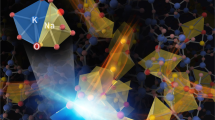Abstract
The structure of spectroscopically pure silica glass is analyzed in the framework of the fragmentary model. A sample is prepared from an industrial silica holder used to fix silicon wafers when performing diffusion processes in the manufacturing of integrated microcircuits. The use of hard (Ag) and soft (Cu) X rays in diffraction experiments makes it possible to obtain the atomic radial distribution function (ARDF) of the glass under investigation. It is found that this function is characterized by 14 coordination shells in an ordering range of 10 Å. A comparison of the experimental ARDF with the model ARDFs constructed from structural data obtained for all crystalline modifications of SiO2 allows the inference that the glass structure involves fragments in which the atomic arrangement corresponds to the short- and medium-range orders in the β-quartz crystal. A detailed examination of the experimental and model ARDFs has revealed that the interatomic distances for all atoms belonging to one helical chain in the glass are identical to those in the β-quartz crystal over the entire ordering range. The distances between atoms located in different helical chains are insignificantly lengthened (by less than 3%). The first three maxima in the experimental and model ARDFs are in complete agreement. This indicates that the Si-O-Si angle in the glass under investigation is constant and equal to the corresponding angle in the β-quartz crystal (in the literature devoted to research in silica glasses, this angle is referred to as the “hinge” angle, i.e., an angle varying over a wide range).
Similar content being viewed by others
REFERENCES
Wright, A.C., Neutron Scattering from Vitreous Silica. The Structure of Vitreous Silica: What Have We Learned from 60 Years of Diffraction Studies, J. Non-Cryst. Solids, 1994, vol. 179, pp. 84–115.
Wright, A.C., Diffraction Studies of Glass Structure: The First 70 Years, Fiz. Khim. Stekla, 1998, vol. 24, no.3, pp. 218–265 [Glass Phys. Chem. (Engl. trasl.) vol. 24, no. 3, pp. 148–179].
Wright, A.C., Diffraction Studies of Glass Structure, J.Non-Cryst. Solids, 1990, vol. 123, pp. 129–148.
Yong, D. and Tokuro, N., Wavelength Structural Analysis of Silica Glasses Manufactured by Different Methods, J. Non-Cryst. Solids, 1997, vol. 222, pp. 50–58.
Carol, S.M. and Jeremy, K.B., Geometric Constraints: A Refined Model for the Structure of Silica Glasses, J.Non-Cryst. Solids, 1990, vol. 124, pp. 1–21.
Porai-Koshits, E.A., On the Short-and Medium-Range Orders in Glass Structure, Fiz. Khim. Stekla, 1992, vol. 18, no.5, pp. 43–50 [Sov. J. Glass Phys. Chem. (Engl. transl.), 1992, vol. 18, no. 5, pp. 361–364].
Aleinikova, K.B., Lesovoi, M.V., and Perin, Yu.N., A Fragmentary Model of Atomic Structure of Multicomponent Amorphous Materials with Dominant Covalent Bonding, Izv. Akad. Nauk, Ser. Fiz., 1993, vol. 57, no.2, pp. 85–90.
Kazimirov, V.P., Smyk, S.Yu., and Skol'skii, V.E., Termination Effect in X-ray Diffraction Studies of Disordered Systems, Kristallografiya, 2000, vol. 45, no.1, pp. 12–15.
Nabitovich, I.D., Stetsiv, Ya.I., and Voloshchuk, Ya.V., Determination of Coherent and Background Intensities from Experimental Curve of Electron Scattering, Kristallografiya, 1967, vol. 12, no.4, pp. 584–590.
Sokol'skii, V.E., Kazimirov, V.P., and Shovskii, V.A., Normalization of Intensity Curves in X-ray Diffraction by Disordered Systems, Kristallografiya, 2000, vol. 45, no.3, pp. 398–401.
Gillavry, C.M., Rieck, G.D., and Press, K., International Tables for X-ray Crystallography, Birmingham, 1962.
Vainshtein, B.K., On the Radial Distribution Theory, Kristallografiya, 1957, vol. 2, no.1, pp. 29–37.
Porai-Koshits, M.A., Prakticheskii kurs rentgenostrukturnogo analiza (Practical Course of X-ray Diffraction Analysis), Moscow: Mosk. Gos. Univ., 1960.
Golubkov, V.V., The Structure of and Structural Transitions in Vitreous SiO2, Fiz. Khim. Stekla, 1992, vol. 18, no.1, pp. 57–69 [Sov. J. Glass Phys. Chem. (Engl. transl.), 1992, vol. 18, no. 1, pp. 28–34].
Author information
Authors and Affiliations
Additional information
Original Russian Text Copyright © 2005 by Fizika i Khimiya Stekla, Aleinikova, Likhach.
Rights and permissions
About this article
Cite this article
Aleinikova, K.B., Likhach, N.I. Fragmentary Model as Applied to Analysis of Spectroscopically Pure Vitreous SiO2 . Glass Phys Chem 31, 648–655 (2005). https://doi.org/10.1007/s10720-005-0109-6
Received:
Issue Date:
DOI: https://doi.org/10.1007/s10720-005-0109-6




